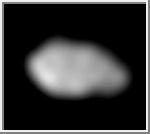















|
Metis [MEE-tis] is the innermost known satellite of Jupiter. It was named after a Titaness who was a consort of Zeus (Jupiter). Metis and Adrastea lie within Jupiter's main ring and may be the source of material for the ring. Very little is known about Metis.
| Views of Metis |
|---|
 Galileo Image of Metis
Galileo Image of Metis
This image of Metis was taken by Galileo's solid state imaging system between
November 1996 and June 1997. Although Metis was discovered by Voyager, it was
no more than a point of light on images. This Galileo image is the
the first image of the small moon that shows its irregular shape.
Metis orbits Jupiter in the zone between the planet's ring and the larger
Galilean satellites. The longest dimension of Metis is approximately 60
kilometers (37 miles) across.
(Courtesy of NASA/JPL)
 Metis
Metis
This image of Metis was taken by the Voyager 1 spacecraft
on March 4, 1979. Metis is the small dark dot above the arrow.
(Credit: Calvin J. Hamilton)
![]() Family Portrait of the Small Inner Satellites of Jupiter
Family Portrait of the Small Inner Satellites of Jupiter
These images, taken by Galileo's solid state imaging system between
November 1996 and June 1997, provide the first ever "family portrait"
of the four small, irregularly shaped moons that orbit Jupiter
in the zone between the planet's ring and the larger Galilean satellites.
The moons are shown in their correct relative sizes, with north approximately
up in all cases. From left to right, arranged in order of increasing distance
from Jupiter, are Metis (longest dimension is approximately 60 kilometers or
37 miles across), Adrastea (20 kilometers or 12 miles across), Amalthea
(247 kilometers or 154 miles across), and Thebe (116 kilometers or 72 miles
across). While Amalthea, the largest of these four tiny moons, was imaged
by NASA's two Voyager spacecraft in 1979 with a resolution comparable to what
is shown here, the new Galileo observations represent the first time that
Metis, Adrastea, and Thebe have been seen as more than points of light.
(Courtesy of NASA/JPL)
| References |
|---|
Synnott, S. P. "1979J3: Discovery of a Previously Unknown Satellite of Jupiter." Science, Vol 212, 19 June 1981.
Synnott, S. P. "Orbits of the Small Inner Satellites of Jupiter." Icarus 58, 1984.
Copyright © 1997 by Calvin J. Hamilton. All rights reserved.